Throwing Light on Supernova: A Mathematically Envisioned Perspective Fostered on the Entrancing Cosmological Phenomenon
Newsletter
Subscribe now to get notified about IU Nagaland Journal updates!
Search
Throwing Light on Supernova: A Mathematically Envisioned Perspective Fostered on the Entrancing Cosmological Phenomenon
Pallavi SaikiaAssistant Professor and Ph.D. Research Scholar, Department of Mathematics, Apex Professional University, Pasighat, Arunachal Pradesh.
Abstract:
A supernova is one of the most powerful and energetic cosmological phenomena in the universe. It is an enormous explosion that occurs when a star dies. This can happen in one of two ways: either a massive star reaches the end of its life, or a white dwarf star is pushed into a massive nuclear fusion reaction. White dwarfs are stars that have exhausted their nuclear fuel. They form when a star sheds its outer layers, creating a nebula. Supernovae are fundamentally important for understanding how the universe evolved. An exploding star releases huge amounts of material into space, including elements like carbon, oxygen, and iron. Over billions of years, these elements can form new structures, including planets. Cosmologists estimate that a few supernovae occur every century within galaxies, including our own Milky Way. Supernovae are crucial to explaining the existence of life on Earth, and how other celestial bodies came into being after the Big Bang.
Keywords:
Cosmos, Explosion, Luminous, Super massive, Supernovae.
1.0 Introduction
A supernova has been perceived as one of the most energetic and luminous blast of a star explored in the cosmos. In some time of practice, a white dwarf drags or pulls matter from its companion star which eventually triggers off the white dwarf to a powerful burst, as per the data endorsed on supernovae (NASA Space Science, 2021). These supernovae engrained cosmic bursts are subjected and observed to be so bright that these might outshine or outstrip their far- reaching galaxies for weeks, a few days or which might even stretchable up to months.
While supernovae are rare in any single galaxy, their sheer number across the universe means that astronomers can observe hundreds of them every year outside of the Milky Way. Astrophysicists estimate that in galaxies like our own, a supernova occurs roughly every 50 to 100 years. However, observing these events within the Milky Way is challenging. Interstellar dust blocks the view of most supernovae that happen inside our own galaxy, which is why historical records of visible supernovae are so scarce. The last one directly observed from Earth in our galaxy was Kepler's Supernova in 1604, even though astronomers have since found remnants of more recent, unobserved explosions.
As when a super-giant star is on the verge of experiencing a massive brilliant blast, the star undergoes numerous stages of transformation and it initiates to fuse several elements which consequently forms a belt like enveloping stretching structure in the shape of a red supergiant. Throughout this procedure, further heavy elements get clustered onto the central core. Once the core mass reaches a certain threshold level, it gets collapsed under the predominance of its own enduring gravitational forces. As soon as the central core collapses, the external layers get exploded in its centrifugally outward directions (NASA Space Science, 2021).At the peak arrival point of during its bursting, a supernova can emit bright light which is sufficient to illuminate the entire galaxy of the blasting star and even can stretch up to a diameter encompassing a traversal elongation of nearly numerous light-years ahead.
2.0 Interpretational Embedding Mechanism
When a star reaches the end of its life and exhausts its nuclear fuel, it can create an extremely explosive and energetic cosmic event. The final days of a star's life are marked by the exhaustion of its nuclear fuel, which can trigger a stunningly explosive and energetic phenomenon in the cosmos. A star's demise, initiated by the depletion of its nuclear fuel, culminates in an intensely explosive event that generates a highly energetic cosmic phenomenon. When such happens, the exploding stars are known as supernovae (NASA Space Science, 2021 and US Department of Energy). A supernova generates a giant bang which is approximately billions of times luminous than the Sun, accompanied by plentiful energy to outshine its individual galaxy for a time span which is additionally lengthier than weeks. These colossal blasts release enormous amounts of matter out into cosmological province of space.
Fig. 1: A visual depiction of one of the brightest and exceedingly energetic supernova blasts forever and ever recorded in the universe
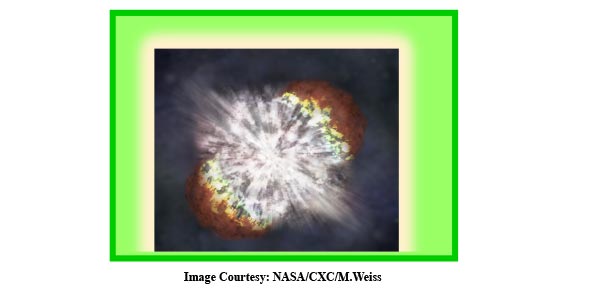
3.0 Conceivable Perspectives at the Bursting Impinge sofa Supernova
Conceptualizing a scenario when a tremendously super massive celestial object such as star, roughly eight times grander than the Sun whenever crosses the threshold of its evolutionary stages of the end segment of its life expectancy, the spectacular observations perceived as:
- The star necessarily constructs a red supergiant by eventually coalescing diverse substances in its atmospheric ambiance in the cosmos.
- A core-collapse supernova occurs when the central core of a massive star collapses under its own immense gravitational force. This event leaves behind a centrally condensed core, either a black hole or a neutron star, surrounded by blisteringly hot gases that form a nebula. A black hole is a region of space so dense that its gravity prevents even light from escaping.
- The external deposits or clustering of the star got subjected to explosions that are emerging in an outward centrifugally streaming out directions.
- An additional distinct category of supernova, known as a Thermal Runaway Supernova, can transpire as two stars orbiting or revolving around each other and one or both of such stars is essentially a white dwarf which are the remnants subsisting from the eventual spring out of a star that has been approximately the size of the Sun when the star exhausts its entire nuclear fuel at its central core segment, essentially configuring the privilege of a binary system. If the stars persisting in one of such binary systems suffer collision or if one of such white dwarfs soak up sufficient matter from the other star, the white dwarf eventually transpires to a supernova (US Department of Energy and the University of Western Australia).
3.1 The Embedded Mechanism of Core Collapse Supernovaein Connection to Neutron Stars
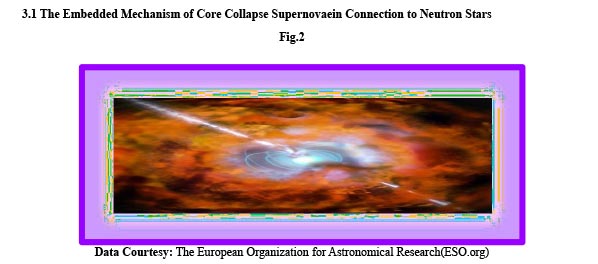
Super luminous supernovae and long-duration gamma-ray bursts have been linked to rapidly spinning neutron stars. A new model suggests that a slight misalignment between the neutron star's spin and its magnetic field axes can power both events. The rotational energy from the neutron star is transferred to the supernova and to a jet of particles traveling at nearly the speed of light, which in turn powers the gamma-ray burst. Astrophysicist Matt Nicholl and his colleagues at the Harvard & Smithsonian Center for Astrophysics (CfA) proposed this unifying model to explain these powerful cosmic events.
3.2 Implementations:
The space scientists are becoming capable of precisely predicting the radio emission and the thermal wind effects along with some of the transient effects visualized during these spectacles.
In general, a core-collapse supernova transpires as when the central iron core of a super- giant star collapses due to gravity and essentially get bounced back that generates pressure waves and the resulting shocks propagate externally. One such extremely rare class of core collapse supernova are the super- luminous supernovae whose luminosity can be equal to 10-1000 billion Suns, this triggers such kind of supernovae to be highly powerful and that subsists as a powerful cosmological object as the radioactive decay of nickel, although the amount of nick present for this mechanism appears to be unsatisfactory.
3.3 Explaining Jet in Connection to Supernovae:
In some supernovae, particularly those resulting from the core collapse of massive stars, powerful jets of material can be ejected along the star's rotational axis. These jets are thought to be driven by either the magneto-rotational mechanism (in the case of neutron star formation) or by neutrinos or magnetic spin-down of the central object. The interaction of these jets with the surrounding stellar material can lead to highly asymmetric and energetic supernova explosions as illustrated by a group of researchers’ viz., Obergaulinger and Reichert (2023) together with Mac Fadyen et al. and Khokhlov, Hoeflich, Oran, Wheeler and Wang (1999).
3.4 Magnetar Misalignment: The Simultaneous Powering Procedure of the Supernovae and the Jet
Let's first formulate the Magnetar Model. Then, we will describe the specific mechanism by which a misaligned or "skew" Magnetar can divide its power into both thermal and magnetized (jetted) components.
The following equation, as explained by Kasen and Bildsten (2010), expresses the luminosity of the entire cosmic system over time:

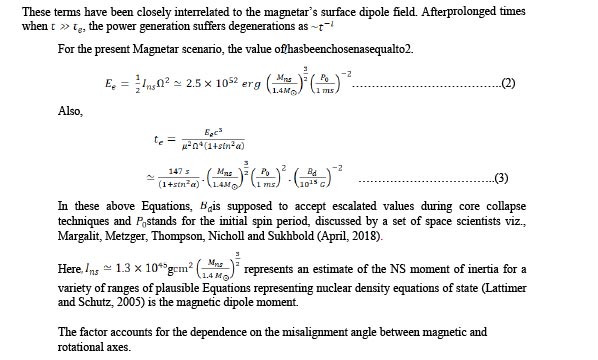
3.5 The Supermassive Black Hole Formation and Its Engrained Cosmic Ambiance:
The creation of supermassive black holes during the explosion of a supernova encompasses the gravitational collapse of the central core segment of massive star. Such cosmic scenario has been illustrated by the Equation which is a correspondence between General Relativity and the characteristic of matter component of the cosmos persisting under tremendous pressure and density.
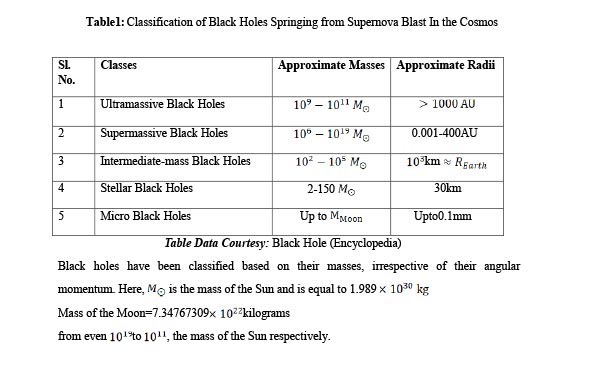
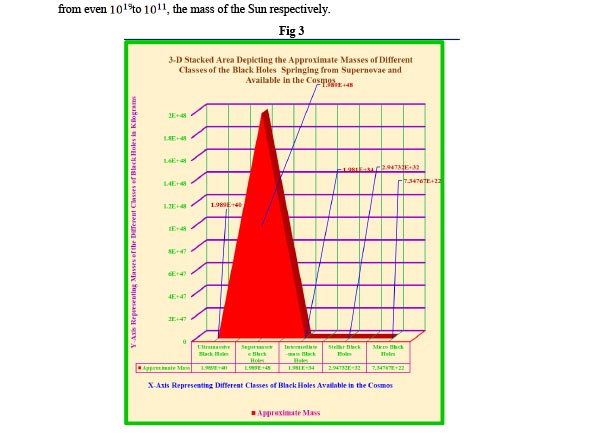
4.0 Exceedingly Fascinating Manifestation sofa Supernova:
- A luminosity of s supernova can be ascendingly billions of times brighter in comparison to the Sun
- A supernova can outshine its own galaxy even for a tenure of weeks
- During the outburst ofa supernova, at its peak ascendency, it can escalate to the expanse of perceiving the diameter of numerous light years
The supernova cosmological phenomenon transpires when a star approximately five times greater or roughly grander than the mass of the sun which eventually drives out accompanied by staggering explosions incurred in the cosmos. - It has been an observed/ experiential scenario in a cosmological terrain that super giant stars burn enormous expanses of nuclear fuel at their innermost central cores. This phenomenon gives rise to immeasurable heaps of energy, eventually making the central core strata tremendously escalating hot. The intensifying heat scales engenders pressure and this pressure essentially being created upon as an upshot rising up due to the star’s innermost central segment burning of its nuclear fuel which supplementarily restrains that star from being collapsed (NASA Space Science, 2021).
- In the above-mentioned circumstance, a star which has been under the supremacy of supernova explosion at the final part of its survival span, it is under the persistence of balancing to establish an equilibrium that comes to play between two antagonist forces. The gravity subsisting inside the star efforts to squeeze the star into the tiniest, tightest conceivable sphere. While the burning of the nuclear fuel in the central core of the star accentuates sturdy outward pressure. However, this outward push/drive restricts the inward squeeze emphasized due to gravitational attraction functional in the star (NASA Space Science, 2021).
5.0 Mechanism Predictable for Holding Up a Star
It is a standpoint of stability that gets created due to the force of gravity strident on the star and on the other side balancing is enacted due to the enormous heat and pressure, pushing in the externally outward direction from the innermost core of the star. In the cosmic province, sometimes cosmological settings ensue whilst a super gigantic star at the final part of its survival, exhausts its entire nuclear fuel and eventually gets cools off. This triggers the pressure to falloff. Gravity wins out, as a consequence of which the star experiences impulsive breakdowns/ collapses. Such class of supernova collapse materializes so speedily that it produces gargantuan shock waves that trigger off the exterior segment of the star to a state of colossal bang. These Categories of supernovae are known as Core-Collapsed Supernova. Some of such fascinating cosmological phenomena give rise to a quantifiable numeral of incredible speculations.
According to NASA Space Science (2021), observations entail the statistics that an extremely impassable condensed core of a celestial object in general has long been drawn-out, accompanying by a spreading out of blisteringly hot gas cloud referred to as a nebula. A supernova formed due to the bursting of star whose expanse has been compared to more than roughly ten times the size of the sun has been supposed to get ahead of the formation of one the compact entities in the cosmos, known as black holes.
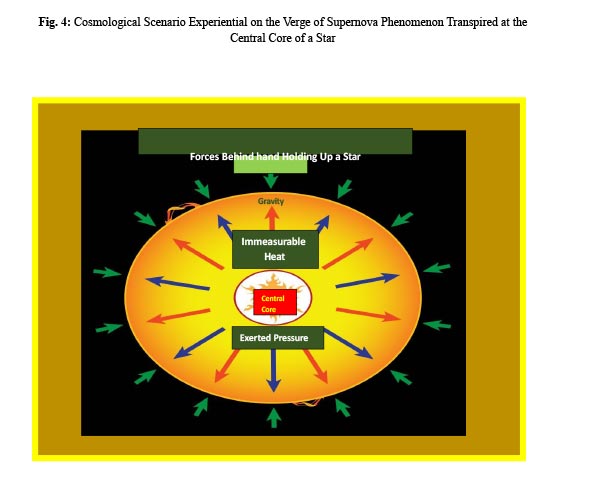
5.1 The Excretory Product of a Supernova:
- 5.1.1 The gigantic bang accentuates a shock wave which predominantly compresses cosmic substances prevalent in its close province and generates several essentials viz., zinc, silver, tin, gold, mercury, lead and uranium.
- 5.1.2 The persisting remnants from such super massive explosions presumed to be fused to the gateway of some into new stars
6.0 Experimental Methods Deployed to Explore Supernovas:
The NuSTAR (Nuclear Spectroscopic Telescope Array) Mission, which has been practicalized by the NASA scientists’ team that uses X-ray visualization in the telescope in order to search for supernova explosions and set for investigations. NuSTAR is providing data to the space researchers about the young nebulas regarding the visualization of the real scenarios behindhand the formation tactics, during the survival endurance and posterior to these enormous explosions.
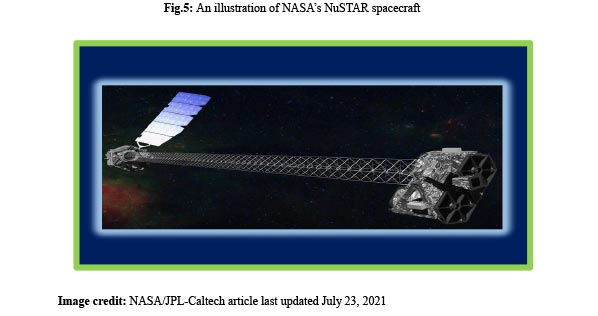
7.0 Nomenclature Technique of Supernovae:
As and when supernovae are discovered, they have to be informed to the International Astronomical Union’s Central Bureau for Astronomical Telegrams. After informing to this unit, a supernova has been designated with its précised name. It has been a usual convention that a supernova has been named by using the capital case letters of the two letters viz., S, N. Thus, right from the starting of the precede SN, trailed by the discovered year, suffixed with either one or two-lettered categorization. The first 26supernovae that have been identified and observed of a particular year are assigned with the capital letters of English Alphabet, encompassing 26letters of Capital Letters from A to Z. Succeeding, a pair of lower-case letters have been used such as aa, aa, ab and so on. Thus, for instance, the designationSN2006D essentially redirects to the information that it is a supernova that had been the Fourth informed supernova of the year 2006. Another example includes the last supernova of the year 2005 (Let us suppose) which is SN 2005nc that had been predicted as the discovery no. 376 of the year 2005 since it leads to the logically involved simplification step that endorses the embedded logic as 14 × 26 + 3 = 367. From the very year 2000, several astronomers have been succeeded in detecting quite a lot numerals of hundreds of supernovae every year, for instance, reportedly 527 supernovae in the year 2007, subsequent year 2008 reported a numeral of 261 and this raised to a numerical value of 390 in 2009 and 231 numbers of detected supernovae in 2013.
7.1 Antiquity of the Experimentally Observed Ground work:
The most primitive probable supernova had been ever endorsed as HB9 was noted to be viewed and identified by an unidentified Indian native who made a note about the observation on a rock structure in the Burzahama locality of Kashmir during 3500- 5500 B.C., spectacularly investigated by Joglekar, Vahia and Sule (2011). Posterior to this, another supernova, named SN 185 was observed and noted by a China based astronomer in the 185 A.D. Following this observation, history endorsed several such supernova detection and investigation in the subsequent epochs. The examples of such incidences include: SN 1006 in 1006 AD which has been recorded to be the most luminous supernovae ever observed in the Lupus Constellation of the cosmic domain. Astronomers from different countries viz., China, Japan, Iraq, Egypt and Europe. The names of some these can be mentioned as Murdin and Murdin (1985), Burnham, Jr. Robert (1978) and Winkler, Gupta and Long, all of whom had evidenced the observation of this supernova. Crab nebula produced SN 1054 supernova by Fraknoi et.al. (2022).
Two observed Milky Way Supernovae viz., 1572 and SN1604 had been observed in our Milky Way that influenced advancement of Astronomy in Europe which contradicted the ideology of the ancient Greek philosopher, Aristotle who portrayed the notion of a static universe subsisting beyond the Moon and planets since the supernova explosion enlighten the submerged in adequacy of proper knowledge showing that each celestial constituent of the universe has been experiencing motion rather than stationary. Another astronomer named Tycho Brahe observed a supernova named SN 1572 in Cassiopeia, a constellation in the northern sky. Johannes Kepler’s name can be uttered in this connection since he observed SN 1604 supernova in the Milky Way on its peak brightnessstateon17thOctober in1604 till its fading away state which continued and complete fading away transpired till 1605, a year later. However, the newly-flanged supernova detected in the Milky Way in the 19th Century is presumed to be G1.9+0.3, data furnished by scientists Joglekar, Vahia and Sule (2011).
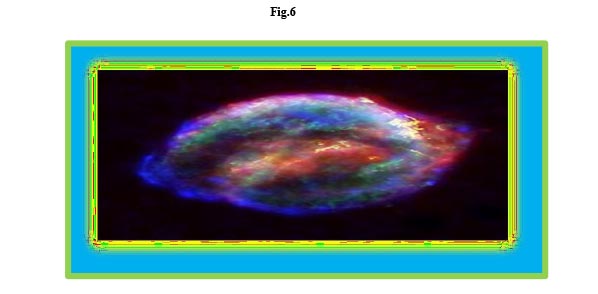
The cosmological phenomenon incurred in the cosmos are subjected to numerous stages of cosmic evolutionary slants which for some stances go beyond the survival period of a general human entity. The examples of which include the supernovae blasts that might appear within the galaxy for a period of hundred years and even more than it whereas in some other cases, they might transpire inside the same far-stretched galaxy after a time interval of years and additionally years after years but not surpassing a centenary span which might not be easily distinguishably visible in the cosmological province due to the sturdy presence of the opaque cosmic dusts. However, some fast revolutionary theories suggest that somewhere in the universe as it is exceedingly intensified and enduring under the dominant surveillance of dark energy which has been predominantly responsible for the hurried expansion of the cosmos, a supernova essentially ensues in every 10 seconds [15].
Hubble's sharp vision mechanism of exploring supernova directs that those supernovae, subsisting billions of light years apart from earth, are readily impossible for other existing telescopes across the world to explore. The supernova impingements observed using Hubble's sharp vision can be viewed that generally balances close to the image of its accommodating galaxy. Hubble could make a distinction between the light waves approaching from vivid sources and thereby could straightforwardly make observations concerning to a supernova.
An illustrating fact that creeps in those cosmological speculations, concerning to a measuring mechanism, named as Cepheid variables, apprehended in case of some stars, those have been coordinated in far-stretched galaxies which vibrate at a previously presumed expectable rate with their vibrating skills that are straightly connected to intrinsic brightness of the far detached galaxies that permits the space researchers to stick to these as standard candles in enumerating the remoteness to such galaxies as described by the Las Cumbres Observatory. Fundamentally, this has been achieved by means of evaluating the period of a Cepheid variable in a remote galaxy, the space researchers become capable of assessing its absolute luminosity which subsequently help them in computing its aloofness grounding on the intensity of luminosity as it appears on Earth.
The significant characteristic of Cepheid variables is that their period of vibration is directly proportional to their absolute luminosity which in turn redirects that an elongated pulsation phase assuredly indicating the presents of a brighter star. In a simpler sense, by comparing the previously mentioned luminosity to the apparent brightness of the galaxies, space scientists become capable of estimating the remoteness to that galaxy as information furnished by NASA, USA, the Goddard Space Flight Center. Cepheid variables are significantly applied in Cosmology in ascertaining the extragalactic distance scale, that is very much needed for comprehending the exponential expansion of the universe due to the negative pressure force called dark energy and which has been apprised in computing the Hubble constant.
Cepheids are a very amazing category of variable star portraying the characteristics such as very stable and foreseeable fluctuating brightness. Astrophysicists have used Hubble parameter to speculate Cepheids with exceptional outcomes and have been implicated as benchmark for numerically computing the distances to supernovae which has been presumed as a perfect measuring tool in scaling out the cosmos, illustrated by Las Cumbres Observatory and NASA, USA, the Goddard Space Flight Center.
8.0 Supernova Categories:
Supernovaecanbedividedbroadlyintothefollowingfourmajorcategories,viz.,
- Type I a
- Type I b and
- Type II
The above mentioned categorization has been made on the ground of nature of bursting out or explosion of the super-colossal stars in their respective cosmic domain.
A brief analysis of the characteristics of each of these three typesa re discussed below:
Type I a Supernova:
- This type of supernova generates in binary systems as a subsequent outcome of the powerful bang incurred while a white dwarf star undergoes a brilliant luminous spontaneous blowing off in the cosmological province.
- The spectral lines contain no trace of hydrogen.
- Can raise up to three times luminous in comparison to a Type II Supernova.
- One similar characteristic to that of a Type II Supernova is in the facet of expansion which can occur two times swifter as a Type II Supernova
Type I b Supernova:
- Transpires only when a super- giant star collapses under the effect of its own sturdy gravitational field.
- The supremacy of hydrogen elements in the extreme exterior boundary or envelope of the star undergoes snatched apart and become uncovered or exposed.
Type II Supernova:
- Another name exists as a Core-Collapsed Supernova.
- Generates as an up shot of massive bursting out of gigantic stars.
- The star, on the verge of lustrous bang ought to be as a minimum aggregate of eight times grander than the mass of the Sun.
- This powerful detonating trails a blisteringly hot cluster of gas elements, essentially forming a nebula.
- This predominantly creates the scenario of a neutron star or a black hole in the cosmos.
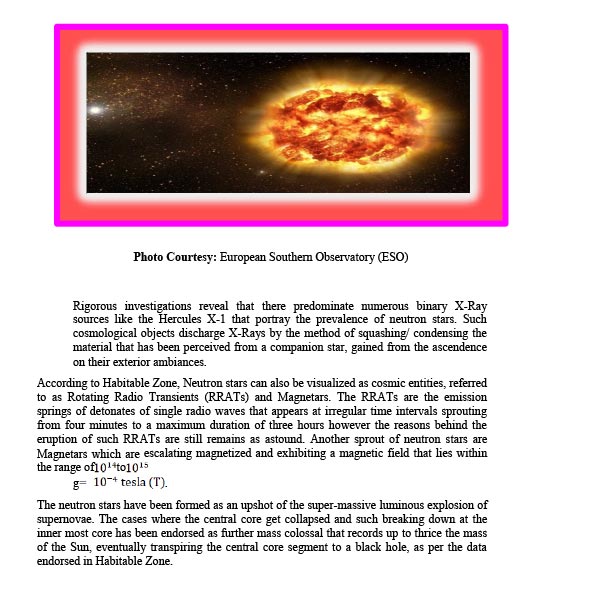
9.0 Springs of Heavy Elements in the Universe
Fig. 8: Periodic Table eventually featuring the springs of each of the elements predominant in the Interstellar Medium (ISM)
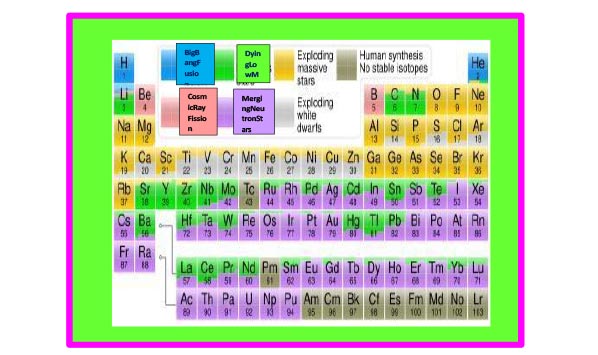
Supernovae are the most vital springs of elements in the interstellar medium from the profusion of oxygen to rubidium, however the speculative sufficiency of the elements generated or visualized in the visible spectra of light waves fluctuates effectively subject to diverse nature of supernovae.
- Silicon and heavily iron engrained elements and metals like nickel and iron are profuse in the cosmos due to Type I a Supernovae.
- Core collapse supernovae also discharge iron-engrained elements in the universe which contain the aggregated iron enriched value of less percentages in comparison to Type I a Supernovae. However, these discharge greater masses of light alpha elements like oxygen and neon, accompanied by elements weightier than zinc. One special ejection source of zinc in the universe is due to electron capture supernovae.
- The unwrapped/ uncovered substance get emission from the sources of Type II Supernova are an essential abundance of the elements, consisting of hydrogen and helium gases The heavyweight elements are formed due to the process of Nuclear Fusion reaction for nuclei up to . The r-process generates exceedingly unstable nuclei, brimming or overflowing in neutrons. The r-process reactions have been entirely accountable for almost nearly half of all the isotopes of elements surpassing iron in the Periodic Table whereas these are expected to be generated due to some supplementary reactions also prevalent in the cosmic ambiance.
- Hydrogen, helium and traces of lithium have been profound from the sturdy cosmological phenomenon named as Big Bang; the effectual speculation accountable for the genesis of the universe. Apart from Hydrogen and Helium profusion in the interstellar medium of the cosmos, the other elements have been referred to as metals which eventually augment the formation of molecular clouds responsible for formation of stars in the cosmos.
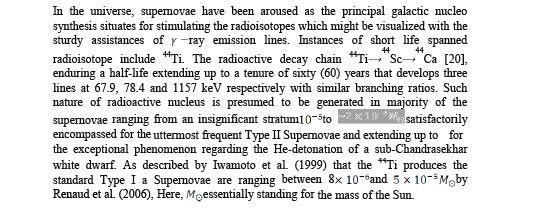
Bombardment of Cosmic Rays onEarth and its Escalating Abundance in the Cosmos:
Supernova residuals are provoked for accelerating a huge stratum of primary beam of cosmic rays streaming out from galaxies. However, evidences endorse only a negligible fragment of cosmic rays which are supposed to be disbursed from the supernovae remnants. The experimentalized coming out of gamma rays are subjected from Pion decay which can be observed and investigated from two supernovae residuals viz., IC 443 and W44. Charged pions frequently decay into muons and muon neutrinos since neutral muons generally decay into gamma rays.
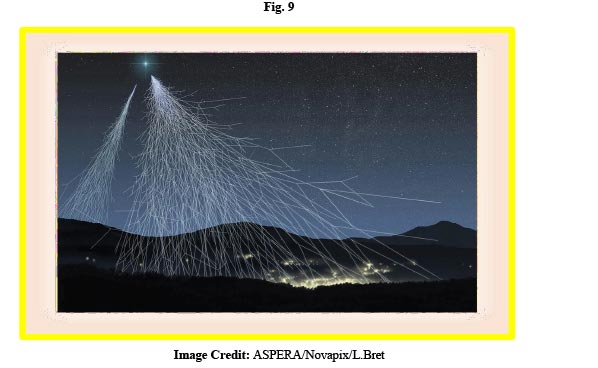
Fig. 9 entails the propagating trajectories of the cosmic rays, colliding with atmospheric particles, invading the Earth’s magnetic lines of force and finally arriving at the Earth’s ground. During night time, these rays have been captured in the cosmic ray detectors. The image has been taken from a snapshot available from the data: ASPERA/Novapix/L. Bret
Gravitational Waves:
Another sturdy interstellar spring of evolution of gravitational waves are presumed to be the supernovae. Almost majority of the gravitational wave signals as have been projected by Supernova Models are detected to be of very much short lengthen in time span which even persists for less than one second and thereby producing complexity while detecting.
10.0 Supernovae Affecting the Planet Earth:
Among several supernovae detections in the galaxies, the category called near-Earth supernova represents a closely located supernova, near to the Earth and which has significant impetus in the Earth’s biosphere. Based on the nature of bursting and amounts of energy release mechanism during and post bursting away of the supernovae, these near-Earth supernovae have been estimated to be locating at a detachment of approximately 3000 light years from the Earth.
- In the year 1996, experiments grounded on previously investigated theories focused on information gathered on earlier observed supernovae which are supposed to be available on Earth in the texture of metal isotopes are found in rocks.
- An enrichment of Iron- 60 had been detected in the later epoch in the traces of rocks found in the Pacific Ocean.
- In2009, Antarctic ice had been profound to intensified echelons of nitrate ions which got matched with the 1006 and 1054 supernovae investigatory results.
- The streaming and bombardment of Gamma rays that spring from near-Earth supernova might be the reason of increasing the ambiance levels of nitrogen oxides and expected to be stuck in the Antarctic ice.
- The antiquity envisioned on the supernovae lead to the fact that this near-Earth supernova essentially affects the biodiversity which eventually disturbs life survival on planet Earth. An upsurge in the bombardment of cosmic rays might be the reason of forming a chiller temperature. A mighty temperature gap between the Poles and the Equator is responsible for the formation of sturdier wind propagation, a hurried mixing of ocean waters which eventually lead to the conveyance of nutrients to shallow waters along with the continental shells or layers which consequently perturbs the bio-diversity podium.
- According to a report furnished in the year 2003, the Type II Supernova might be nearer to the earth at a detachment of about 26 light-years which is sufficient to annihilate half of the Earth’s depleted ozone layer which is recorded to be spanning approximately to an extent of 500 light years.
11.0 Supernovas in Leading the Science of Cosmology a Step Further:
11.1 Enlightening Facts about Supernovas:
- Space researchers get edified by observing and analyzing the supernovas. They set for investigating that specific type of supernovae which takes into account of the white dwarfs which the astronomers implement like a ruler to quantity the remoteness between the different celestial objects in interstellar province.
- Supernovas are the radiant sources essential for survival of life on Earth. Stars are the productive centres of many chemical components. At the central core, stars convert simple elements such as hydrogen atoms into a few heavier elements like carbon and nitrogen. These elements are the most indispensable for life expectancy on Earth as per informatics of the University of Western Australia.
- The utmost supermassive stars are capable of generating heavy elements, such as gold, silver and uranium. During gigantic blasts, stars disintegrate to fabricate both formerly assembled piled up and a freshly-created elements right throughout the cosmos.
- As per the US Department of Energy, in our enduring universe, supernovae are springs of elements, radiation and neutrinos.
- By visualizing and understanding the supernovae, the space researchers’ knowledge is not only restrained to build perceptions on the complex as well as devastating demises of colossal stars in the cosmos, at the same instance captivates the humankind to through light on the investigatory analysis of the genesis of the cosmos which at the same pace, fortifies the erudition regarding the formation of heavier elements in the cosmos which are also needed for the endurance of lives on the planet Earth as illustrated by researcher Parks (2023).
12.0 Examples of some observed supernovas and endorsed in the Cosmological Antique investigations
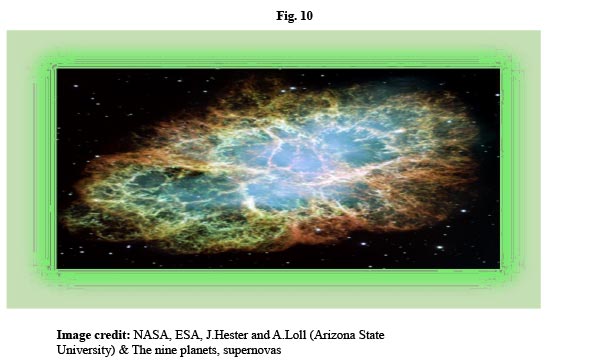
The above Fig. 10, essentially portraying the state of The Crab Nebula which has been generated due to the remnant formed as a part of the post powerful super massive bright explosion of a colossal star in the Milky Way. This spectacular observance came endorsed as a supernova in the year 1054.
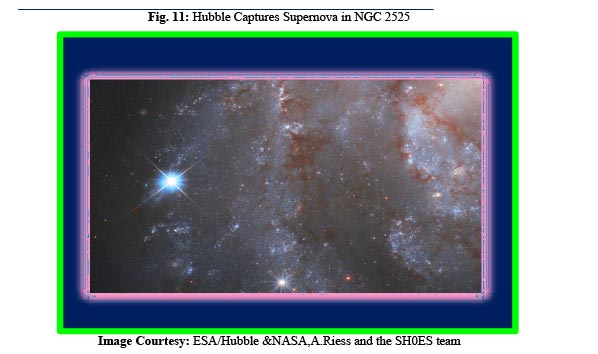
The above Fig. 11, deploys the captivating galaxy NGC 2525 which had been located almost nearly 70 million light-years dethatched apart from the Earth which is a part of the constellation of Pupp is situated in the southern hemisphere.
On the extreme left portion of the picture, a brilliant supernova has been distinctly visualized. This supernova was primarily named as SN2018gv which was first recognized in the middle of January, 2018. The NASA/ESA Hubble Space Telescope captured this supernova in a barred spiral galaxy, located at a distance of approximately seventy million light years detached from the Earth, named as NGC 2525, discovered on 23rd February, 1791.
References:
- NASA Space Science, What is a supernova? https://spaceplace.nasa.gov/supernova/en/,Article last updated July 23, 2021.
- An official website of the United States government, US Department of Energy, https://www.energy.gov/science/doe-explainssupernovae
- Death of a star: the University of Western Australia.
- Obergaulinger, M. and Reichert, M. (2023), Nucleo synthesis in jet-driven and jet- associated supernovae, High Energy Astrophysical Phenomena (astro-ph.HE), arXiv:2303.12458v1 [astro- ph.HE]
- MacFadyen, A.I., Woosley, S.E. and Heger, A., Supernovae, Jets and Collapsars, IOP The Astrophysical Journal, Vol. 550 (1).
- Khokhlov, A.M., Hoeflich, P.A., Oran, E.S., Wheeler, J.C. and Wang, L. (1999), Jet-induced explosions of core collapse supernovae, Astrophysical Journal Letter, http://doi.org/10.1086/312305
- Kasen, D.andBildsten, L. (2010), Supernova light curves powered by young magnetars, High Energy Astrophysical Phenomena (astro-ph.HE), arXiv:0911.0680v1 [astro-ph.HE], http://doi.org/10.1088/0004-637X/717/1/245
- Margalit,B.,Metzger,B.D.,Thompson,T.A.,Nicholl,M.andSukhbold,T.(April,2018), The GRB-SLSN Connection: misaligned magnetars, weak jet emergence and observational signatures, Monthly Notices of the Royal Astronomical Society, Vol. 457, Issue2, pp. 2659-2674, http://doi.org/10.1093/mnras/sty013.
- Jaiswal,A., Kumar, R., Srivastava, S.K., Govender, M. and Pacif., S.K.J. (February22, 2024), Black hole formation in gravitational collapse and their astrophysical implications, IOP Publishing Ltd, Physica Scripta, Vol. 99 (3), http://doi.org/10.1088/1402-4896/ad25cc.
- Joglekar, H., Vahia, M. N. and Sule, A. (2011), Oldest sky-chart with Supernova Record (in kashmir), Purattatva: Journal of the Indian Archaeological Society, pp. 207- 211.
- Murdin, P., Murdin, L. (1985), Supernovae, Cambridge University Press, pp. 14-16, ISBN: 978-0521300384.
- Burnham,RobertJr.(1978),The Celestial Handbook, Dover,pp.1117-1122.
- Winkler,P.F.,Gupta,G.andLong,K.S.,TheSN1006Remnant:opticalpropermotions,deep imaging, distance and brightness at maximum, Astrophysical Deep Imaging Journal, pp. 324- 335, arXiv: astro-ph/0208415.
- Fraknoi,A.et.al.(2022),Astronomy2e.,OpenStax.P.767,ISBN:978-1-951-69350-3.
- Las Cumbres Observatory, Cepheid Variable Stars, Supernovae and Distance Measurement.
- NASA,Cepheid Variables as Cosmic Yardsticks,Goddard Space Flight Center.
- Habitable Zone. https://www.britannica.com/science/neutron-star.
- Renaud,M.,Vink,J.,Decourchelle.,A.,Lebrun,F.,Terrier,R.andBallet,J.(October,2006), An Integral IBIS view of young galactic SNRs through the 44Ti gamma-ray lines, New Astronomy Reviews, Vol. 50 (7-8), pp. 540-543,http://doi.org/10.1016/j.newar.2006.06.06
- Parks.J. (November17, 2023), The different types of supernovae explained, SpaceWaves.